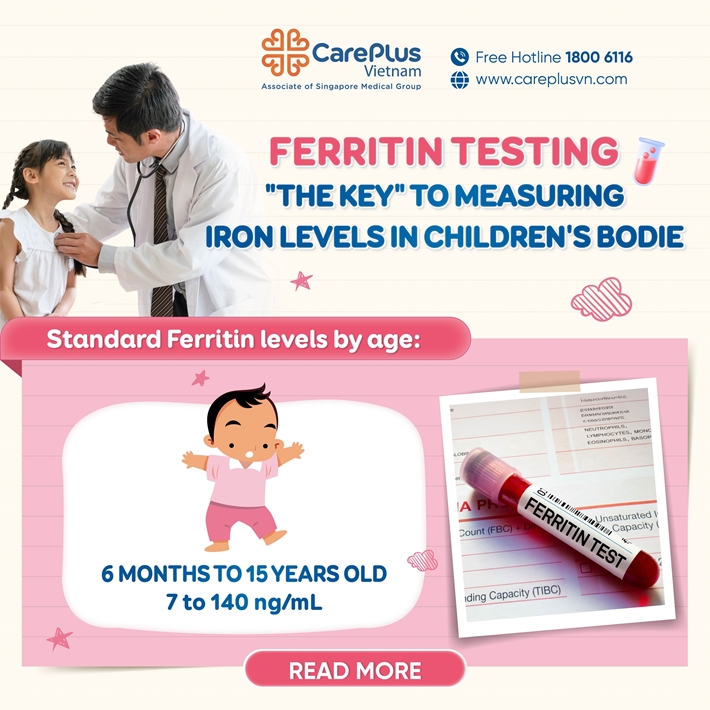FERRITIN TEST – THE GOLDEN KEY TO MEASURING IRON LEVELS IN CHILDREN’S BODIES

4/21/2025 9:53:26 AM
Being outwardly healthy doesn't always mean the body has all the necessary micronutrients!
At CarePlus International Clinic, there have been cases where children undergoing routine health check-ups were unexpectedly found to have low Ferritin levels. A decrease in Ferritin is not only seen in children with anemia, malnutrition, or poor appetite, but also in seemingly healthy and normally developing children—even in those who are overweight or obese, with no clinical symptoms. If not promptly addressed through proper dietary adjustments and regulation of Ferritin levels, these children may be at risk of developing iron-deficiency anemia, which can negatively impact their health, immune function, growth, and overall development.
So, what exactly is Ferritin, and when should this test be performed for children? Let’s explore more with CarePlus in the article below.
1. What is a Ferritin Test?
The Ferritin test is used to measure the level of Ferritin in the blood. Ferritin is a type of protein responsible for storing iron and releasing it as needed by the body’s organs and tissues. Simply put, this test tells us how much iron is stored in a person’s body. Abnormally high or low Ferritin levels may indicate underlying health issues, especially those related to the circulatory system. This test plays an essential role in diagnosing, monitoring, and guiding the appropriate adjustment of Ferritin levels.
2. Benefits of Ferritin Testing in Children
- Ferritin testing can be used to screen for iron deficiency in high-risk groups: including premature and low birth weight infants, growing children, picky eaters, those with malnutrition, overweight or obese children, or children on unbalanced diets or vegetarian/vegan diets.
- A drop in Ferritin level is often the first sign of iron deficiency.
- This test is useful for diagnosing iron-deficiency anemia: when low Ferritin is accompanied by reduced hemoglobin levels, it is a typical indicator of this condition.
- It can also help in diagnosing and monitoring iron overload disorders, such as Thalassemia.
3. What to Do After Receiving Your Child’s Ferritin Test Results
Normal Ferritin levels vary by age, sex, health status, and testing standards. Results are usually reported in ng/mL or µg/L.
Typical Ferritin reference ranges:
- Newborns: 25–200 ng/mL
- 1-month-old infants: 200–600 ng/mL
- 2–5 months: 50–200 ng/mL
- Children (6 months to 15 years): 7–140 ng/mL
A Ferritin level of less than 15 ng/mL in children is typically diagnosed as iron deficiency.
Based on the test results and the child's overall health, the doctor will provide appropriate recommendations and interventions:
- Dietary Adjustments: If Ferritin levels are low, the child should follow an iron-rich diet, including foods such as red meat, liver, seeds, legumes, and iron-fortified products.
- Iron Supplements: In cases of severe Ferritin deficiency or if dietary intake is insufficient, the doctor may prescribe iron supplements as part of a treatment regimen.
The Ferritin test is a crucial tool for parents and healthcare providers to assess a child’s iron storage levels. It helps determine whether the child is iron deficient—a vital factor for both physical and cognitive development. Alongside Ferritin testing, parents are encouraged to schedule regular comprehensive health check-ups to monitor all essential health indicators, ensuring their child remains healthy and develops holistically.
References
1. World Health Organization. WHO guideline on use of ferritin concentrations to assess iron status in individuals and populations. Geneva: World Health Organization; 2020. https://www.who.int/publications/i/item/9789240000124
2. University Medical Center Ho Chi Minh City. What is a Ferritin test? https://umcclinic.com.vn/xet-nghiem-dinh-luong-ferritin-la-gi
3. Medscape: https://emedicine.medscape.com/ferritin